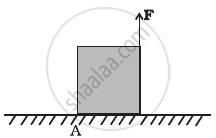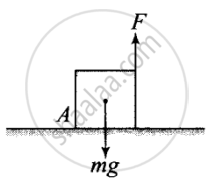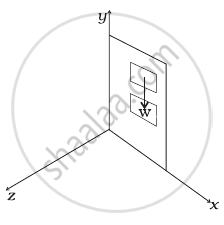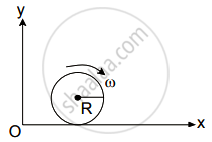Advertisements
Advertisements
Question
A uniform cube of mass m and side a is placed on a frictionless horizontal surface. A vertical force F is applied to the edge as shown in figure. Match the following (most appropriate choice):

| (a) mg/4 < F < mg/2 | (i) Cube will move up. |
| (b) F > mg/2 | (ii) Cube will not exhibit motion. |
| (c) F > mg | (iii) Cube will begin to rotate and slip at A. |
| (d) F = mg/4 | (iv) Normal reaction effectively at a/3 from A, no motion. |
Solution
| (a) mg/4 < F < mg/2 | (ii) Cube will not exhibit motion. |
| (b) F > mg/2 | (iii) Cube will begin to rotate and slip at A. |
| (c) F > mg | (i) Cube will move up. |
| (d) F = mg/4 | (iv) Normal reaction effectively at a/3 from A, no motion. |
Explanation:
Consider the below diagram
Moment of the force F about point A, τ1 = F × a .....(anti-clockwise)
Moment of weight mg of the cube about point A.
τ2 = `mg xx a/2` .....(clockwise)

Cube will not exhibit motion, If τ1 = τ2 ......(∵ In this case, both the torque will cancel the effect of each other)
∴ F × a = `mg xx a/2`
⇒ F = `(mg)/2`
Cube will rotate only when, τ1 > τ2
⇒ F × a > `mg xx a/2`
⇒ `F > (mg)/2`
Let the normal reaction is acting at `a/3` from point A, then
`mg xx a/3 = F xx a` or `F = (mg)/3` .......(For no motion)
When F = `(mg)/4` which is less than `(mg)/3`, .....`(F < (mg)/3)`
There will be no motion.
APPEARS IN
RELATED QUESTIONS
Find the components along the x, y, z axes of the angular momentum l of a particle, whose position vector is r with components x, y, z and momentum is p with components px, py and 'p_z`. Show that if the particle moves only in the x-y plane the angular momentum has only a z-component.
The ratio of the acceleration for a solid sphere (mass m and radius R) rolling down an incline of angle θ without slipping and slipping down the incline without rolling is, ______
Define torque and mention its unit.
State conservation of angular momentum.
A particle of mass 5 units is moving with a uniform speed of v = `3sqrt 2` units in the XOY plane along the line y = x + 4. Find the magnitude of angular momentum
The net external torque on a system of particles about an axis is zero. Which of the following are compatible with it?
- The forces may be acting radially from a point on the axis.
- The forces may be acting on the axis of rotation.
- The forces may be acting parallel to the axis of rotation.
- The torque caused by some forces may be equal and opposite to that caused by other forces.
A door is hinged at one end and is free to rotate about a vertical axis (Figure). Does its weight cause any torque about this axis? Give reason for your answer.

A spherical shell of 1 kg mass and radius R is rolling with angular speed ω on horizontal plane (as shown in figure). The magnitude of angular momentum of the shell about the origin O is `a/3 R^2` ω. The value of a will be:

A rod of mass 'm' hinged at one end is free to rotate in a horizontal plane. A small bullet of mass m/4 travelling with speed 'u' hits the rod and attaches to it at its centre. Find the angular speed of rotation of rod just after the bullet hits the rod 3. [take length of the rod as 'l']
A particle of mass 'm' is moving in time 't' on a trajectory given by
`vecr = 10alphat^2hati + 5beta(t - 5)hatj`
Where α and β are dimensional constants.
The angular momentum of the particle becomes the same as it was for t = 0 at time t = ______ seconds.
